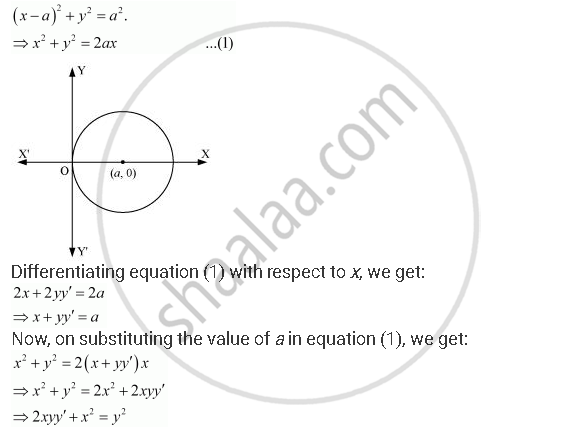Advertisements
Advertisements
प्रश्न
Form the differential equation of the family of circles touching the y-axis at the origin.
उत्तर
The centre of the circle touching the y-axis at origin lies on the x-axis.
Let (a, 0) be the centre of the circle.
Since it touches the y-axis at origin, its radius is a.
Now, the equation of the circle with centre (a, 0) and radius (a) is

This is the required differential equation.
APPEARS IN
संबंधित प्रश्न
Form the differential equation of the family of parabolas having vertex at origin and axis along positive y-axis.
Form the differential equation of the family of ellipses having foci on y-axis and centre at origin.
Form the differential equation of the family of circles in the first quadrant which touch the coordinate axes.
Form the differential equation corresponding to y = emx by eliminating m.
Form the differential equation from the following primitive where constants are arbitrary:
y = cx + 2c2 + c3
Form the differential equation from the following primitive where constants are arbitrary:
y = ax2 + bx + c
Find the differential equation of the family of curves, x = A cos nt + B sin nt, where A and B are arbitrary constants.
Form the differential equation corresponding to y2 = a (b − x2) by eliminating a and b.
Form the differential equation corresponding to y2 − 2ay + x2 = a2 by eliminating a.
Represent the following families of curves by forming the corresponding differential equations (a, b being parameters):
x2 + (y − b)2 = 1
Represent the following families of curves by forming the corresponding differential equations (a, b being parameters):
y = ax3
Represent the following families of curves by forming the corresponding differential equations (a, b being parameters):
x2 + y2 = ax3
Represent the following families of curves by forming the corresponding differential equations (a, b being parameters):
y = eax
Find one-parameter families of solution curves of the following differential equation:-
\[x\frac{dy}{dx} - y = \left( x + 1 \right) e^{- x}\]
Find one-parameter families of solution curves of the following differential equation:-
\[x\frac{dy}{dx} + y = x^4\]
Find one-parameter families of solution curves of the following differential equation:-
\[\left( x \log x \right)\frac{dy}{dx} + y = \log x\]
Find one-parameter families of solution curves of the following differential equation:-
\[e^{- y} \sec^2 y dy = dx + x dy\]
Write the order of the differential equation representing the family of curves y = ax + a3.
The family of curves in which the sub tangent at any point of a curve is double the abscissae, is given by
Form the differential equation of the family of ellipses having foci on y-axis and centre at the origin.
Form the differential equation representing the family of curves `y2 = m(a2 - x2) by eliminating the arbitrary constants 'm' and 'a'.
Find the area of the region bounded by the curves (x -1)2 + y2 = 1 and x2 + y2 = 1, using integration.
Form the differential equation representing the family of curves y = A sin x, by eliminating the arbitrary constant A.
Find the differential equation of the family of curves y = Ae2x + B.e–2x.
Find the equation of a curve whose tangent at any point on it, different from origin, has slope `y + y/x`.
Find the equation of a curve passing through the point (1, 1) if the perpendicular distance of the origin from the normal at any point P(x, y) of the curve is equal to the distance of P from the x-axis.
Find the equation of a curve passing through (2, 1) if the slope of the tangent to the curve at any point (x, y) is `(x^2 + y^2)/(2xy)`.
Find the equation of the curve through the point (1, 0) if the slope of the tangent to the curve at any point (x, y) is `(y - 1)/(x^2 + x)`
The curve for which the slope of the tangent at any point is equal to the ratio of the abcissa to the ordinate of the point is ______.
Find the equation of the curve at every point of which the tangent line has a slope of 2x:
The area above the x-axis and under the curve `y = sqrt(1/x - 1)` for `1/2 ≤ x ≤ 1` is:
